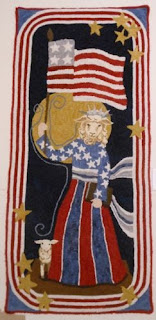This post is more practical than most. Its subject is the little toolbox I have put together to help me with hanging shows, whether at the medicentre gallery, where I hang the work of local artists, or at my own shows, or even in my studio, attaching hanging hardware to finished work. About the size of a shoebox, I can just pick it up and throw it in the car, knowing it will serve me well.
I got the idea from Carole Lessard, an artist with a very professional approach to her work and to her shows.
Here's what's inside the toolbox:
Pliers, to screw eye-screws into stretcher bars
A screwdriver with multiple heads
A small hammer
Wire cutters
A level no bigger than a fountain pen
(Mom, what's a fountain pen?)
A black marker for signing the backs of canvases
or to touch up chipped black paint
Pencil
Chalk for marking sightlines on walls
A measuring tape

A dustcloth for dusty frames
Framing and hanging hardware
Masking tape for marking white walls
Picture wire
Blue sticky gum to affix labels to walls and to
secure the lower corners of canvases to the walls
Disposable wet wipes to clean smudges on glass
The all-important red sticky dots to indicate
sales
The cover of the toolbox lifts to reveal storage compartments for eye-screws and finishing nails.

Fibre artists might include a small pair of scissors for snipping stray threads. Masking tape curled around the palm of your hand can be useful to collect loose threads.
I usually pack a camera in my purse.
I can't tell you how often this little kit has come to the rescue, so I'm sharing this mundane item, hoping it might prove to be useful to you too.








 Fibre artists might include a small pair of scissors for snipping stray threads. Masking tape curled around the palm of your hand can be useful to collect loose threads.
Fibre artists might include a small pair of scissors for snipping stray threads. Masking tape curled around the palm of your hand can be useful to collect loose threads.












